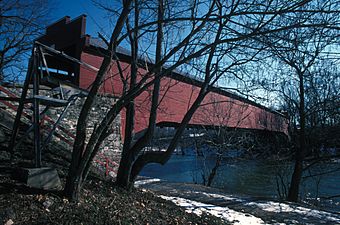Wertz's Covered Bridge facts for kids
Quick facts for kids |
|
|
Wertz's Covered Bridge
|
|
 |
|
| Location | Northwest of Reading on Township 921, Bern Township and Spring Township, Pennsylvania |
|---|---|
| Area | less than one acre |
| Built | 1867 |
| Built by | Amandas Kneer |
| Architectural style | Burr arch truss |
| MPS | Berks County Covered Bridges TR (AD) |
| NRHP reference No. | 78002347 |
| Added to NRHP | November 17, 1978 |
Wertz's Covered Bridge, also known as the Red Covered Bridge, is a really old and cool wooden bridge in Berks County, Pennsylvania. It's a special type of bridge that has a roof and sides. This design protects the wooden parts from rain and snow. It's located between Bern Township and Spring Township.
Discovering Wertz's Covered Bridge
Wertz's Covered Bridge is a famous landmark. It's known for its unique design and long history. This bridge helps people cross the Tulpehocken Creek. It's a great example of old-time engineering.
What Makes It Special?
This bridge is quite long, measuring about 204 feet (or 62 meters). It uses a special building style called a Burr Truss. This design uses strong wooden arches and a framework of beams. It helps the bridge hold a lot of weight.
Wertz's Covered Bridge is very important for a few reasons. It is one of only five covered bridges still standing in Berks County. Plus, it holds the record for being the largest single-span covered bridge in all of Pennsylvania! This means it crosses the entire distance without any support in the middle.
Today, the bridge is a special entrance. It leads to the Berks County Heritage Center. This center is a fun place to visit. It also includes the Gruber Wagon Works, which is another historic site.
A Look at Its History
The Wertz's Covered Bridge was built way back in 1867. It has seen many years go by! In 1959, the bridge got some repairs. This work happened from April 10 to August 3. However, later that year, on October 23, the bridge was closed to traffic forever. This happened when a new road, the Warren Street Bypass, opened nearby.
Even though it was closed to cars, the bridge was still important. On November 17, 1978, it was added to the National Register of Historic Places. This list includes places that are important to American history.
The bridge got a big makeover from June to December in 1984. During this time, many parts were fixed or replaced. Workers put on new siding and replaced some floorboards. They also lifted the bridge to make it straight again. The old, rotted ends of the arches were replaced. Even the roof got new cedar shingles! These repairs helped keep the bridge strong and beautiful.



